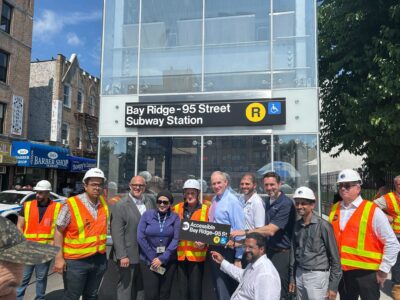BAY RIDGE — When eighth grader Ibrahim Amtiaz first joined the Code Squad two years ago — William McKinley Junior High School’s digital coding club — the building’s internet could barely keep up.
“When I started on the Code Squad in sixth grade, our internet was really slow. It took a long time for our programs to load and fewer of my teachers used technology in the classroom because it took so long to set things up,” Amtiaz said.
His school wasn’t alone.
As of this school year, every New York City school building has gotten a broadband upgrade to at least 100 megabits per second, Schools Chancellor Richard Carranza announced Wednesday from Amtiaz’s school auditorium in Bay Ridge.
Just five years ago, Carranza said, not even 10 of the city’s 13,000-plus schools could say that.
“We have high expectations for all of our students, and we want them to have the tools to be successful. Yet, at the start of this administration, technology wasn’t necessarily where we wanted it to be, the infrastructure wasn’t where it needed to be and it was not serving our students well,” said the schools chancellor.

Councilmember Mark Treyger, a former educator who chairs the council’s Committee on Education, told the Brooklyn Eagle that slow speeds in school buildings isn’t an isolated issue.
“Too many schools face issues with even accessing the internet due to structural issues, including wiring problems and lack of internet bandwidth,” Treyger said Wednesday, adding that, in meeting with educators and parents, he’s learned that “a number of schools lacked the technological capacity to provide 21st century access to students.”
Earlier this year, Manhattan Borough President Gale Brewer raised similar concerns. In February, she released a study that found that only eight of 78 sampled schools in her borough had Wi-Fi speeds fast enough to utilize basic cloud-based technologies like Google Drive. Futhermore, Brewer’s report found that 18 of the 78 campuses had a difference of at least five megabits per second (and five schools had differences closer to 30).
The new speeds are systemwide — and will come with an additional $750 million in funding for internet availability across the city, Carranza said Wednesday.
“Our minimum speed is now 10 times faster than it was five years ago,” he said, “and as you heard from Ibrahim, that makes a world of difference in the learning for our students.”
Most schools previously connected at 10 megabits per second, according to Carranza, meaning that teachers and students could lose an entire class period waiting for web pages to load. Current speeds would do the same in seconds, he said.
“While there is still more work to do, this is a major investment in our students,” Treyger said of the upgrade. “Our students deserve access to every learning opportunity possible, and this investment in our schools’ internet capacity is a great way to help ensure our students are prepared for their futures.”

 MTA celebrates 95th Street station’s new elevators
MTA celebrates 95th Street station’s new elevators  Cops arrest man in fatal hit-and-run in Bensonhurst
Cops arrest man in fatal hit-and-run in Bensonhurst